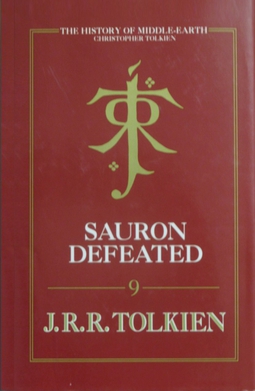
The History of Middle-earth is a 12-volume series of books published between 1983 and 1996 by George Allen & Unwin in the UK and by Houghton Mifflin in the US. They collect and analyse much of J. R. R. Tolkien's legendarium, compiled and edited by his son Christopher Tolkien. The series shows the development over time of Tolkien's conception of Middle-earth as a fictional place with its own peoples, languages, and history, from his earliest notions of "a mythology for England" through to the development of the stories that make up The Silmarillion and The Lord of the Rings. It is not a "history of Middle-earth" in the sense of being a chronicle of events in Middle-earth written from an in-universe perspective; it is instead an out-of-universe history of Tolkien's creative process. In 2000, the twelve volumes were republished in three limited edition omnibus volumes. Non-deluxe editions of the three volumes were published in 2002.
The Notion Club Papers is an abandoned novel by J. R. R. Tolkien, written in 1945 and published posthumously in Sauron Defeated, the 9th volume of The History of Middle-earth. It is a time travel story, written while The Lord of the Rings was being developed. The Notion Club is a fictionalization of Tolkien's own such club, the Inklings. Tolkien's mechanism for the exploration of time is through lucid dreams. These allow club members to experience events as far back as the destruction of the Atlantis-like island of Númenor, as narrated in The Silmarillion.
Ælfwine the mariner is a fictional character found in various early versions of J. R. R. Tolkien's Legendarium. Tolkien envisaged Ælfwine as an Anglo-Saxon who visited and befriended the Elves and acted as the source of later mythology. Thus, in the frame story, Ælfwine is the stated author of the various translations in Old English that appear in the twelve-volume The History of Middle-earth edited by Christopher Tolkien.
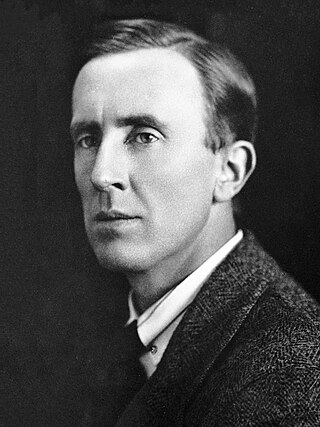
J. R. R. Tolkien came to feel that the flat earth cosmology he embodied in his legendarium would be unacceptable to a modern readership. In The Silmarillion, the Earth was created flat and was changed to round as a cataclysmic event during the Second Age in order to prevent direct access by Men to Valinor, home of the immortals. In the Round World Version, the Earth is created spherical from the beginning.
The works of J. R. R. Tolkien have generated a body of research covering many aspects of his fantasy writings. These encompass The Lord of the Rings and The Silmarillion, along with his legendarium that remained unpublished until after his death, and his constructed languages, especially the Elvish languages Quenya and Sindarin. Scholars from different disciplines have examined the linguistic and literary origins of Middle-earth, and have explored many aspects of his writings from Christianity to feminism and race.
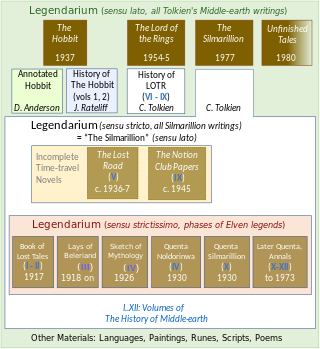
Tolkien's legendarium is the body of J. R. R. Tolkien's mythopoeic writing, unpublished in his lifetime, that forms the background to his The Lord of the Rings, and which his son Christopher summarized in his compilation of The Silmarillion and documented in his 12-volume series The History of Middle-earth. The legendarium's origins reach back to 1914, when Tolkien began writing poems and story sketches, drawing maps, and inventing languages and names as a private project to create a mythology for England. The earliest story, "The Voyage of Earendel, the Evening Star", is from 1914; he revised and rewrote the legendarium stories for most of his adult life.

Tolkien's Legendarium: Essays on The History of Middle-earth is a collection of scholarly essays edited by Verlyn Flieger and Carl F. Hostetter on the 12 volumes of The History of Middle-earth, relating to J. R. R. Tolkien's fiction and compiled and edited by his son, Christopher. It was published by Greenwood Press in 2000. That series comprises a substantial part of "Tolkien's legendarium", the body of Tolkien's mythopoeic writing that forms the background to his The Lord of the Rings and which Christopher Tolkien summarized in his construction of The Silmarillion.
Verlyn Flieger is an author, editor, and Professor Emerita in the Department of English at the University of Maryland at College Park, where she taught courses in comparative mythology, medieval literature, and the works of J. R. R. Tolkien. She is well known as a Tolkien scholar, especially for her books Splintered Light, A Question of Time, and Interrupted Music. She has won the Mythopoeic Scholarship Award four times for her work on Tolkien's Middle-earth writings.

The Silmarillion is a book consisting of a collection of myths and stories in varying styles by the English writer J. R. R. Tolkien. It was edited, partly written, and published posthumously by his son Christopher Tolkien in 1977, assisted by Guy Gavriel Kay, who became a fantasy author. It tells of Eä, a fictional universe that includes the Blessed Realm of Valinor, the ill-fated region of Beleriand, the island of Númenor, and the continent of Middle-earth, where Tolkien's most popular works—The Hobbit and The Lord of the Rings—are set. After the success of The Hobbit, Tolkien's publisher, Stanley Unwin, requested a sequel, and Tolkien offered a draft of the writings that would later become The Silmarillion. Unwin rejected this proposal, calling the draft obscure and "too Celtic", so Tolkien began working on a new story that eventually became The Lord of the Rings.
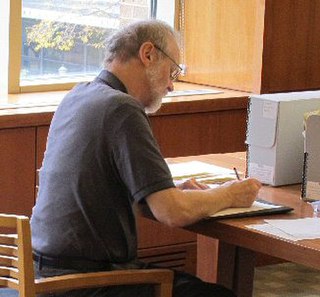
Richard Carroll West was an American librarian and one of the first Tolkien scholars. He is best known for his 1975 essay on the interlace structure of The Lord of the Rings, for which he won the 1976 Mythopoeic Scholarship Award for Inkling Studies.

The music of Middle-earth consists of the music mentioned by J. R. R. Tolkien in his Middle-earth books, the music written by other artists to accompany performances of his work, whether individual songs or adaptations of his books for theatre, film, radio, and games, and music more generally inspired by his books.
J. R. R. Tolkien used frame stories throughout his Middle-earth writings, especially his legendarium, to make the works resemble a genuine mythology written and edited by many hands over a long period of time. He described in detail how his fictional characters wrote their books and transmitted them to others, and showed how later in-universe editors annotated the material.
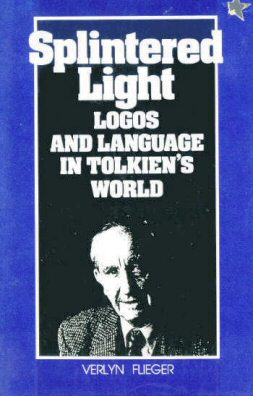
Splintered Light: Logos and Language in Tolkien's World is a 1983 book of literary criticism by the leading Tolkien scholar Verlyn Flieger, in which she argues that light is a central theme of Tolkien's Middle-earth mythology, in particular in The Silmarillion. It has been admired by other scholars to the extent that it has become a core element of Tolkien scholarship.

Tolkien's Art: 'A Mythology for England' is a 1979 book of Tolkien scholarship by Jane Chance, writing then as Jane Chance Nitzsche. The book looks in turn at Tolkien's essays "On Fairy-Stories" and "Beowulf: The Monsters and the Critics"; The Hobbit; the fairy-stories "Leaf by Niggle" and "Smith of Wootton Major"; the minor works "Lay of Autrou and Itroun", "The Homecoming of Beorhtnoth", "Imram", and Farmer Giles of Ham; The Lord of the Rings; and very briefly in the concluding section, The Silmarillion. In 2001, a second edition extended all the chapters but still treated The Silmarillion, that Tolkien worked on throughout his life, as a sort of coda.
Bradford Lee Eden is a librarian and musicologist, best known as a Tolkien scholar.
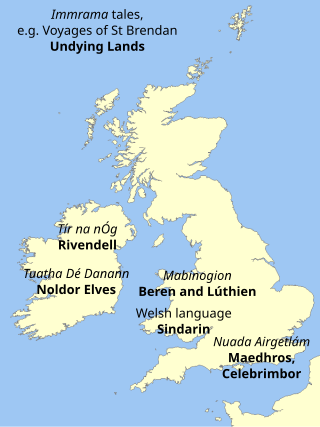
J. R. R. Tolkien derived the characters, stories, places, and languages of Middle-earth from many sources. Among these are the Celtic legends and languages, which for Tolkien were principally Irish and Welsh. He gave multiple conflicting reasons for his liking for Welsh. Tolkien stated directly that he had made use of Welsh phonology and grammar for his constructed Elvish language Sindarin. Scholars have identified multiple legends, both Irish and Welsh, as likely sources of some of Tolkien's stories and characters; thus for example the Noldorin Elves resemble the Irish Tuatha Dé Danann, while the tale of Beren and Lúthien parallels that of the Welsh Culhwch and Olwen. Tolkien chose Celtic names for the isolated settlement of Bree-land, to distinguish it from the Shire with its English names.
J. R. R. Tolkien decided to increase the reader's feeling that the story in his 1954–55 book The Lord of the Rings was real, by framing the main text with an elaborate editorial apparatus that extends and comments upon it. This material, mainly in the book's appendices, effectively includes a fictional editorial figure much like himself who is interested in philology, and who says he is translating a manuscript which has somehow come into his hands, having somehow survived the thousands of years since the Third Age. He called the book a heroic romance, giving it a medieval feeling, and describing its time-frame as the remote past. Among the steps he took to make its setting, Middle-earth, believable were to develop its geography, history, peoples, genealogies, and unseen background in great detail, complete with editorial commentary in each case.

The English author J. R. R. Tolkien has often been supposed to have spoken of wishing to create "a mythology for England". It seems he never used the actual phrase, but various commentators have found his biographer Humphrey Carpenter's phrase appropriate as a description of much of his approach in creating Middle-earth, and the legendarium behind The Silmarillion.
Elizabeth Whittingham is a former lecturer in English at the State University of New York College, Brockport, New York. She is known for her Tolkien studies research, including her 2008 book The Evolution of Tolkien's Mythology, which examines the development of his legendarium as published in the 12-volume The History of Middle-earth.

A Question of Time: J.R.R. Tolkien's Road to Faërie is a 1997 book of literary analysis by Verlyn Flieger of J. R. R. Tolkien's explorations of the nature of time in his Middle-earth writings, interpreted in the light of J. W. Dunne's 1927 theory of time, and Dunne's view that dreams gave access to all dimensions of time. Tolkien read Dunne's book carefully and annotated his copy with his views of the theory. A Question of Time examines in particular Tolkien's two unfinished time-travel novels, The Lost Road and The Notion Club Papers, and the time-travel aspects of The Lord of the Rings. These encompass Frodo's dreams and the land of the Elves, Lothlórien.













